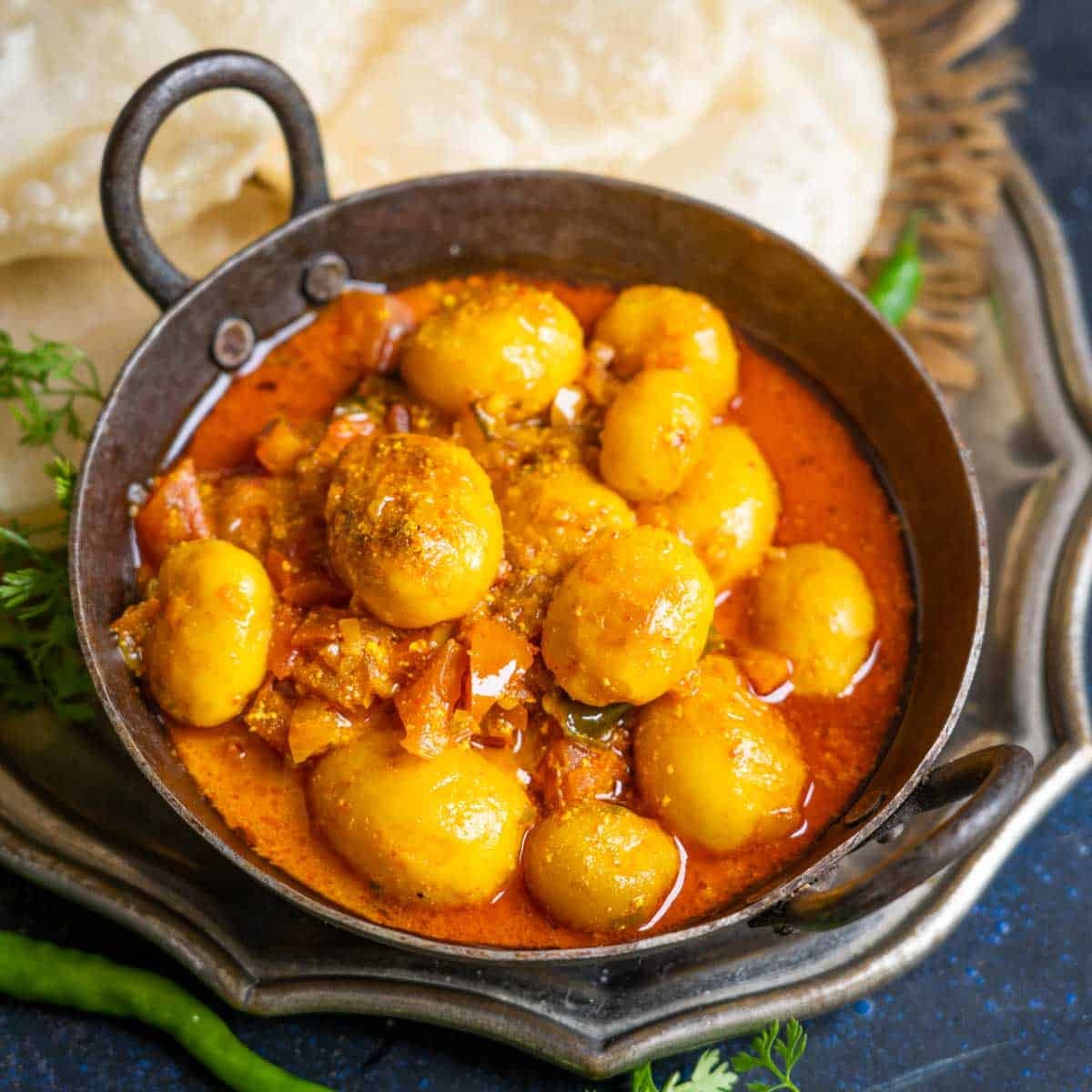Bengali Style “Alu’r Dom”
‘Alu’r dom’ is Bengali for spicy curried potatoes (Kashmiri aloo dum is perhaps the most famous variant of the dish). In Bengal, alu’r dom is made from newly harvested baby potatoes or ‘notun alu’ during the winter months. Generally served with luchi or koraishuti’r kochuri, polao, or fried rice, alu’r dom is a popular winter dish. It is a vegetarian recipe, made without onion or garlic, in Bengali cuisine, known as niramish (vegetarian). As a result, we can serve it as bhog.
The recipe is easy, delicious, and takes only 30 minutes to make. It’s important to have perfectly tender and evenly salted potatoes in an alu’r dom because who likes under-seasoned potatoes?
For this recipe, baby potatoes are twice boiled – once in heavily salted water (with their skin on) and then again in curry for approximately one hour.
The ‘Notun alu’ are notorious for not allowing salt or spices to penetrate easily. Due to this, they need to be cooked longer than usual potatoes.
Alur dom is most commonly served with matar kochuri or luchi in Bengali homes. Still, it can also be served with phulkas and parathas.
Some Bengali homes make Bengali aloo dum with no onion or garlic, and the recipe is called Niramish Dum Aloo.
It is a must-make dish for Bengali festive occasions, weddings, and other special occasions, such as birthdays and get-togethers.
It is important to note that dum aloo is made in numerous parts of India in many ways.
Why Will You Love This Recipe?
As you prepare the dish. Your kitchen fills with the soothing aroma of warm spices and slow-cooked potatoes.
Even though the potatoes remain whole, they are still tender every time you bite into one. Gravy is spicy and mildly sweet due to the coarsely ground whole spices added at the end.
Serving Suggestions
- The best way to enjoy Bengali aloo dum is by pairing it with bhoger khichuri, radha ballavi, matar kochuri, or luchi.
- The dish is also great with Indian bread like phulkas, tawa parathas, lachha parathas, and pooris.
- Additionally, it goes well with jeera rice, Bengali-style veggie pulao, matar pulao, and other light-spiced pulao.
Storage Suggestions
This delicious Bengali potato curry will last for 3-4 days if kept in an airtight container in the refrigerator. Then reheat it in the microwave or on the stove until it’s nice and hot. When reheating, add a bit of water and adjust the consistency to your preference.
Nutrition
- Calories: 260kcal
- Carbohydrates: 27g
- Protein: 4g
- Fat: 15g
- Saturated Fat: 2g
- Cholesterol: 3mg
- Sodium: 197mg
- Potassium: 639mg
- Fiber: 5g
- Sugar: 6g
- Vitamin A: 770IU
- Vitamin C: 33.4mg
- Calcium: 66mg
- Iron: 1.6mg
Tips
- Alternatively, you can pressure-cook the potatoes. On high heat, cook for one whistle, then remove from the heat.
- You don’t want the potatoes to become mushy if you overcook them.
- You can also use regular potatoes cut into 1-inch pieces if you don’t have baby potatoes.
- It’s a good idea to add a teaspoon of all-purpose flour to the yoghurt before cooking in order to prevent it from curdling.
- When making a gluten-free version, be sure not to add hing.
- Use red, fully ripe tomatoes for the gravy to get a rich red colour. Don’t bother de-skinning tomatoes; use both the skin and the pulp.
- I know that peeling all those small potatoes is a tedious and boring task. Go ahead if you’re comfortable keeping the skin on.






